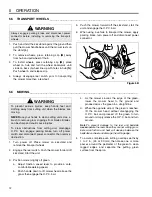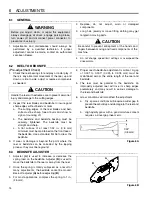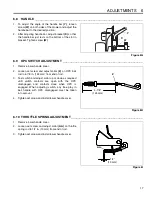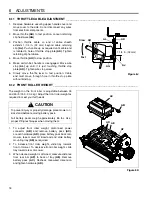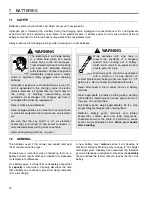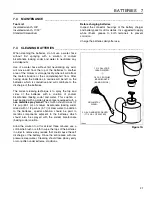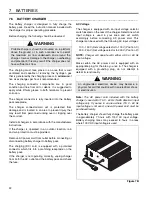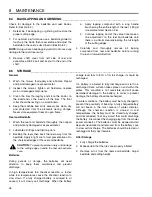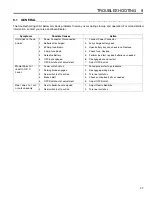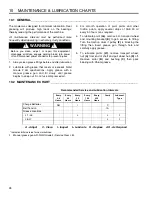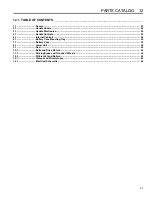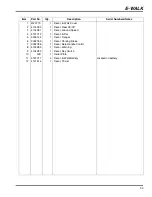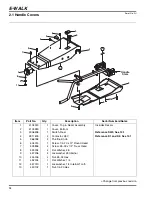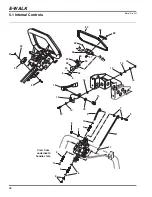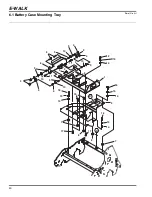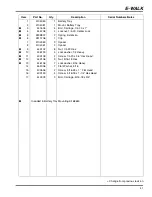
8 MAINTENANCE
26
8.4
BACKLAPPING AND GRINDING _____________________________________________
Check for damage to the bedknife and reel blades.
Refer to (Section 6.2).
1.
Determine if backlapping or grinding will restore the
proper cutting edge.
2.
For optimum performance use a bedknife grinder to
touch-up the blade then reassemble and adjust the
bedknife to the reel as described in (Section 6.2).
NOTE:
Using a bench backlapping unit will not cause any
damage to the reel drive motor.
3.
Remove shaft cover from left side of reel and
assemble a 3/8-24 bolt and locknut to the end of the
shaft.
a.
Apply lapping compound with a long handle
brush along the entire length of the reel, (180 grit
is recommended, Section 2.6).
b.
Continue lapping and at the same time make a
fine adjustment on the reel and bedknife until
there is a uniform clearance along the full length
of the cutting edges.
4.
Carefully and thoroughly remove all lapping
compound from reel and bedknife
before running
the reel in forward direction
.
8.5
STORAGE________________________________________________________________
General
1.
Wash the mower thoroughly and lubricate. Repair
and paint damaged or exposed metal.
2.
Inspect the mower, tighten all hardware, replace
worn or damaged components.
3.
Clean the tires thoroughly and store the tractor on
the kickstand so the load is off the tires. The front
roller should be resting on a wood board.
4.
Keep the machine and all its accessories clean, dry
and protected from the elements during storage.
Never store equipment near an open flame.
Reel and Bedknife
1.
Wash the reel and bedknife thoroughly, then repair
and paint any damaged or exposed metal.
2.
Lubricate all fittings and friction points.
3.
Backlap the reels then back the reel away from the
bedknife. Apply a light coat of rust preventative oil to
the sharpened edges of the reel and bedknife.
Batteries
During periods of storage, the batteries will need
attention to keep them maintained and prevent
discharge.
In high temperatures the chemical reaction is faster,
while low temperatures cause the chemical reaction to
slow down. If a fully charged battery is allowed to sit
unused, it will slowly self discharge. When the battery
charge level falls to 80% of its full charge, it should be
recharged.
If a battery is allowed to fully discharge and is left in a
discharged state, sulfation takes place on and within the
plates. This condition is not reversible and will cause
permanent damage to the battery. In order to prevent
damage, the battery should be recharged.
In winter conditions, the battery must be fully charged to
prevent the possibility of freezing. A fully charged battery
will not freeze in the most severe of winter climates.
Although the chemical reaction is slowed in cold
temperatures, the battery must be stored fully charged,
and disconnected from any circuit that could discharge
the battery. Disconnect the charging plug from the mower
power connector. The batteries must be cleaned and all
deposits neutralized and removed from the battery case
to slow self discharge. The batteries should be tested or
recharged at thirty day intervals.
After Storage
1.
Fully charge the batteries.
2.
Make certain that the tires are properly inflated.
3.
Remove all oil from the reels and bedknife. Adjust
bedknife and cutting height.
CAUTION:
To prevent personal injury and damage
to the cutting edges, handle the reel with extreme
care.
!
Summary of Contents for E-Walk 62290
Page 1: ...Technical Manual GB E Walk 62290 22 11 Blade Reel 4105380 Rev A...
Page 30: ...11 NOTES 30 11 NOTES...
Page 61: ...61 INDEX...

